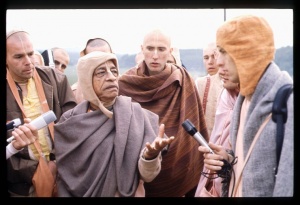SB 10.87.26

A.C. Bhaktivedanta Swami Prabhupada
Please note: The synonyms, translation and purport of this verse were composed by disciples of Śrīla Prabhupāda
TEXT 26
- sad iva manas tri-vṛt tvayi vibhāty asad ā-manujāt
- sad abhimṛśanty aśeṣam idam ātmatayātma-vidaḥ
- na hi vikṛtiṁ tyajanti kanakasya tad-ātmatayā
- sva-kṛtam anupraviṣṭam idam ātmatayāvasitam
SYNONYMS
sat — real; iva — as if; manaḥ — the mind (and its manifestations); tri-vṛt — threefold (by the modes of material nature); tvayi — in You; vibhāti — appears; asat — unreal; ā-manujāt — extending to the human beings; sat — as real; abhimṛśanti — they consider; aśeṣam — entire; idam — this (world); ātmatayā — as nondifferent from the Self; ātma-vidaḥ — the knowers of the Self; na — not; hi — indeed; vikṛtim — the transformations; tyajanti — reject; kanakasya — of gold; tat-ātmatayā — inasmuch as they are nondifferent from it; sva — by Himself; kṛtam — created; anupraviṣṭam — and entered; idam — this; ātmatayā — as nondifferent from Himself; avasitam — ascertained.
Translation and purport composed by disciples of Śrīla Prabhupāda
TRANSLATION
The three modes of material nature comprise everything in this world—from the simplest phenomena to the complex human body. Although these phenomena appear real, they are only a false reflection of the spiritual reality, being a superimposition of the mind upon You. Still, those who know the Supreme Self consider the entire material creation to be real inasmuch as it is nondifferent from the Self. Just as things made of gold are indeed not to be rejected, since their substance is actual gold, so this world is undoubtedly nondifferent from the Lord who created it and then entered within it.
PURPORT
In one sense the visible world is real (sat), while in another it is not (asat). The substance of this universe is solid fact, being the Lord's external energy, but the forms that Māyā imposes on this substance are only temporary. And because material forms are temporary manifestations, those who consider them permanent are in illusion. Impersonalistic scholars, however, misinterpret this division of sat and asat; denying commonsense reality, they declare that not only material form but also material substance is unreal, and they confuse their own spiritual essence with that of the Absolute Whole. A Māyāvādī philosopher would take the words spoken by the personified Vedas in the preceding prayer—tri-guṇa-mayaḥ pumān iti bhidā—as negating any distinction between the Paramātmā and the jīva soul. He would claim that since the jīva's material embodiment is an ephemeral display of the three modes of nature, when the jīva's ignorance is destroyed by knowledge, he becomes the Paramātmā, the Supreme Soul; bondage, liberation and the manifest world are all unreal creations of ignorance. In response to such ideas, the Vedas here clarify the factual relationship between sat and asat.
In the śruti literature we find this statement: asato 'dhimano 'sṛjyata, manaḥ prajāpatim asṛjat, prajāpatiḥ prajā asṛjat, tad vā idaṁ manasy eva paramaṁ pratiṣṭhitaṁ yad idaṁ kiṁ ca. "The supreme mind was originally created from asat. This mind created Prajāpati, and Prajāpati created all living beings. Thus mind alone is the ultimate foundation of everything that exists in this world." Although impersonalists might misread this to mean that all manifest existence is based on the unreality of illusion (asat), the apparently contrary use of the word asat in this passage actually refers to the original cause, the Supreme Godhead, because He is transcendental to material existence (sat). The logic of the Vedānta-sūtra (2.1.17) corroborates this interpretation while denying the wrong interpretation of the impersonalists: asad-vyapadeśān neti cen na dharmāntareṇa vākya-śeṣāt. "If one objects that the material world and its source cannot be of one substance because the world has been called unreal, we reply, 'No, because the statement that Brahman is asat makes sense in terms of His having qualities distinct from those of the creation.' " Thus the Taittirīya Upaniṣad (2.7.1) declares, asad vā idam agra āsīt: "In the beginning of this creation, only asat was present."
In the opinion of Śrīla Jīva Gosvāmī, the word adhimanaḥ in the passage quoted above refers to the ruler of the aggregate mind of the universe, Lord Aniruddha, who appears as a plenary expansion of Śrī Nārāyaṇa when the latter desires to create. Prajāpati is Brahmā, the father of all other created beings. This is described in the Mahā-nārāyaṇa Upaniṣad (1.4): atha punar eva nārāyaṇaḥ so 'nyaṁ kāmaṁ manasā dhyāyet. tasya dhyānāntaḥ-sthasya lalanāt svedo 'patat. tā imā pratatāpa tāsu tejo hiraṇ-mayam aṇḍaṁ tatra brahmā catur-mukho 'jāyata. "Then Lord Nārāyaṇa meditated upon another desire of His, and as He pondered, a drop of perspiration fell from His forehead. All the material creations evolved from the fermentation of this drop. Therein the fiery, golden egg of the universe appeared, and within that globe four-headed Brahmā took his birth."
When a particular object is manufactured, it appears as a transformation of its ingredient cause, as in the case of jewelry made from gold. Persons who want gold will not reject gold earrings or necklaces, since these items are still gold, despite their modification. True jñānīs see in this mundane example an analogy to the different—yet—nondifferent relationship of the Puruṣa and His emanations, both material and spiritual. Thus this transcendental knowledge frees them from the bondage of illusion, for they can then see the Lord throughout His creation.
Śrīla Śrīdhara Svāmī prays,
- yat sattvataḥ sadā bhāti
- jagad etad asat svataḥ
- sad-ābhāsam asaty asmin
- bhagavantaṁ bhajāma tam
"Let us worship the Supreme Personality of Godhead, by virtue of whose substantial existence this created world seems to exist perpetually, although it is essentially insubstantial. As the Supersoul, He constitutes the representation of the real within this unreality."